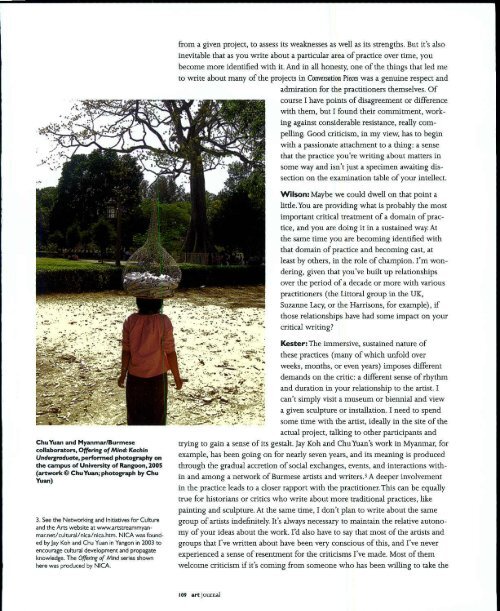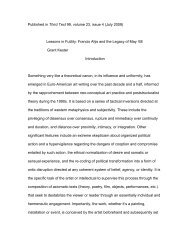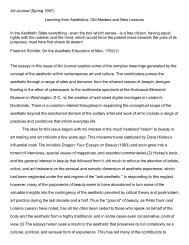Art Journal interview with Mick Wilson - Grant Kester
Art Journal interview with Mick Wilson - Grant Kester
Art Journal interview with Mick Wilson - Grant Kester
Create successful ePaper yourself
Turn your PDF publications into a flip-book with our unique Google optimized e-Paper software.
Chu Yuan and Myanmar/Burmese<br />
collaborators, Offering of Mind: Kachin<br />
Undergraduate, performed photography on<br />
the campus of University of Rangoon, 2005<br />
(artwork 0 Chu Yuan; photograph by Chu<br />
Yuan)<br />
3. See the Networking and Initiatives for Culture<br />
and the <strong>Art</strong>s website at www.artstreammyanmar.net/cultural/nica/nica.htm.<br />
NICA was founded<br />
by Jay Koh and Chu Yuan in Yangon in 2003 to<br />
encourage cultural development and propagate<br />
knowledge. The Offering of Mind series shown<br />
here was produced by NICA.<br />
from a given project, to assess its weaknesses as well as its strengths. But it's also<br />
inevitable that as you write about a particular area of practice over time, you<br />
become more identified <strong>with</strong> it. And in all honesty, one of the things that led me<br />
to write about many of the projects in Conversation Pieces was a genuine respect and<br />
admiration for the practitioners themselves. Of<br />
course I have points of disagreement or difference<br />
<strong>with</strong> them, but I found their commitment, working<br />
against considerable resistance, really compelling.<br />
Good criticism, in my view, has to begin<br />
<strong>with</strong> a passionate attachment to a thing: a sense<br />
that the practice you're writing about matters in<br />
some way and isn't just a specimen awaiting dissection<br />
on the examination table of your intellect.<br />
<strong>Wilson</strong>: Maybe we could dwell on that point a<br />
little. You are providing what is probably the most<br />
important critical treatment of a domain of practice,<br />
and you are doing it in a sustained way. At<br />
the same time you are becoming identified <strong>with</strong><br />
that domain of practice and becoming cast, at<br />
least by others, in the role of champion. I'm wondering,<br />
given that you've built up relationships<br />
over the period of a decade or more <strong>with</strong> various<br />
practitioners (the Littoral group in the UK,<br />
Suzanne Lacy, or the Harrisons, for example), if<br />
. " those relationships have had some impact on your<br />
, - -.. critical writing?<br />
<strong>Kester</strong>: The immersive, sustained nature of<br />
- these practices (many of which unfold over<br />
-.. '. weeks, months, or even years) imposes different<br />
t.i* .,W? Y'... demands on the critic: a different sense of rhythm<br />
and duration in your relationship to the artist. I<br />
S-,- can't simply visit a museum or biennial and view<br />
Sz a given sculpture or installation. I need to spend<br />
some time <strong>with</strong> the artist, ideally in the site of the<br />
actual project, talking to other participants and<br />
trying to gain a sense of its gestalt. Jay Koh and ChuYuan's work in Myanmar, for<br />
example, has been going on for nearly seven years, and its meaning is produced<br />
through the gradual accretion of social exchanges, events, and interactions <strong>with</strong>in<br />
and among a network of Burmese artists and writers. 3 A deeper involvement<br />
in the practice leads to a closer rapport <strong>with</strong> the practitioner. This can be equally<br />
true for historians or critics who write about more traditional practices, like<br />
painting and sculpture. At the same time, I don't plan to write about the same<br />
group of artists indefinitely. It's always necessary to maintain the relative autonomy<br />
of your ideas about the work. I'd also have to say that most of the artists and<br />
groups that I've written about have been very conscious of this, and I've never<br />
experienced a sense of resentment for the criticisms I've made. Most of them<br />
welcome criticism if it's coming from someone who has been willing to take the<br />
109 art journal




